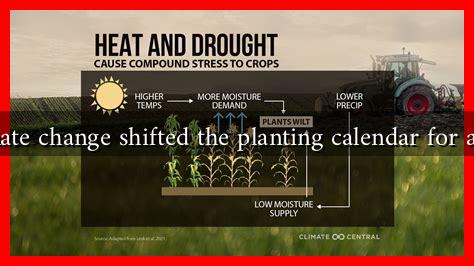-
Table of Contents
How Climate Change Has Shifted the Planting Calendar for Autumn Crops
Climate change is one of the most pressing issues of our time, affecting various aspects of life, including agriculture. As temperatures rise and weather patterns become increasingly erratic, farmers are finding it necessary to adapt their planting calendars. This article explores how climate change has shifted the planting calendar for autumn crops, examining the implications for farmers, food security, and the environment.
The Impact of Climate Change on Agriculture
Climate change has led to significant alterations in agricultural practices worldwide. The following factors are particularly influential:
- Temperature Increases: Average global temperatures have risen, affecting the growing seasons of various crops.
- Altered Precipitation Patterns: Changes in rainfall can lead to droughts or floods, impacting soil moisture and crop yields.
- Increased Pest and Disease Pressure: Warmer temperatures can expand the range of pests and diseases, threatening crop health.
These changes necessitate a reevaluation of traditional planting calendars, particularly for autumn crops, which are typically sown in late summer to early fall.
Shifting Planting Dates
Farmers are increasingly adjusting their planting dates to accommodate the new climate realities. Research indicates that:
- In many regions, the optimal planting window for autumn crops has shifted earlier by several weeks.
- Some farmers are experimenting with new crop varieties that are more resilient to heat and drought.
- In areas where frost dates have become less predictable, farmers are adopting flexible planting schedules.
For instance, a study conducted by the Nature Climate Change journal found that in the Midwest United States, farmers have begun planting corn and soybeans earlier in the spring and harvesting later in the fall due to warmer temperatures. This shift has led to a longer growing season but also increased vulnerability to late-season frosts.
Case Studies: Regional Variations
Different regions are experiencing unique challenges and adaptations due to climate change:
- California: Farmers in California have reported shifting their planting dates for autumn crops like tomatoes and peppers. With warmer autumns, they are planting earlier to avoid the risk of heat stress during critical growth periods.
- Midwest USA: In states like Iowa and Illinois, farmers are increasingly using cover crops to improve soil health and retain moisture, allowing for more flexible planting schedules.
- Europe: In countries like the UK and Germany, farmers are experimenting with new varieties of winter wheat that can be sown later in the season, taking advantage of milder winters.
Implications for Food Security
The shifting planting calendar has significant implications for food security. As farmers adapt to new conditions, several challenges arise:
- Yield Variability: Changes in planting dates can lead to inconsistent yields, affecting food supply chains.
- Increased Costs: Farmers may incur additional costs for irrigation and pest management as they adapt to new growing conditions.
- Market Dynamics: Altered harvest times can disrupt market availability, leading to price fluctuations.
According to the Food and Agriculture Organization (FAO), these challenges could exacerbate food insecurity, particularly in vulnerable regions where agricultural systems are already under stress.
Conclusion: Adapting to a New Reality
Climate change is undeniably reshaping the agricultural landscape, forcing farmers to rethink their planting calendars for autumn crops. As temperatures rise and weather patterns become more unpredictable, the need for adaptation becomes increasingly urgent. By shifting planting dates, experimenting with new crop varieties, and employing innovative farming practices, farmers can mitigate some of the adverse effects of climate change. However, the challenges of yield variability, increased costs, and market disruptions remain significant hurdles that must be addressed to ensure food security in a changing climate.
In summary, understanding and adapting to these shifts is crucial for the future of agriculture and global food systems. As we move forward, collaboration among farmers, researchers, and policymakers will be essential to develop sustainable solutions that can withstand the impacts of climate change.


